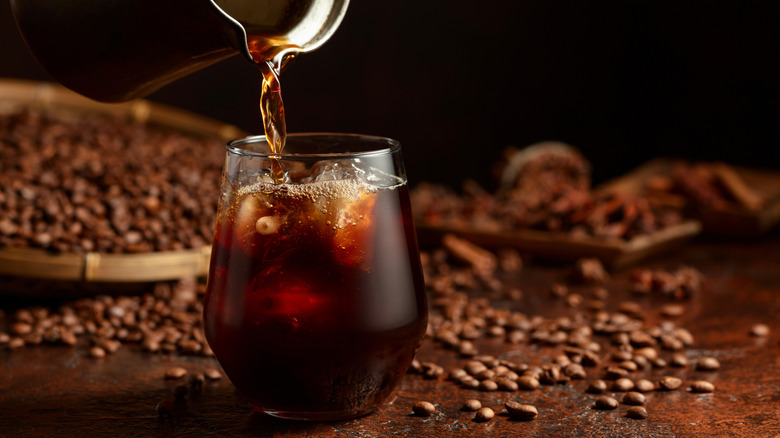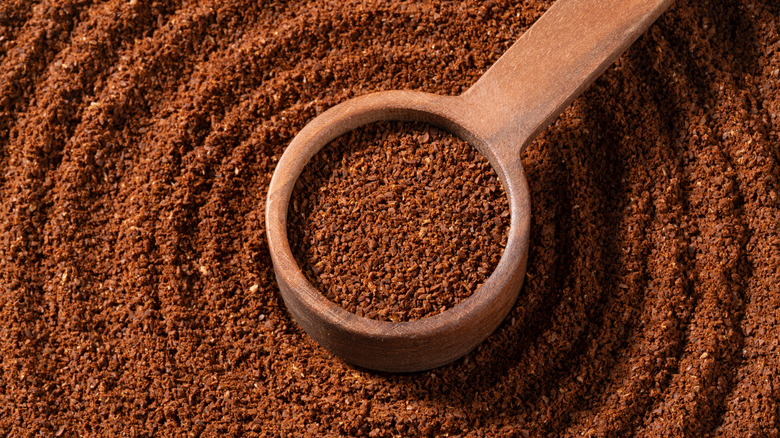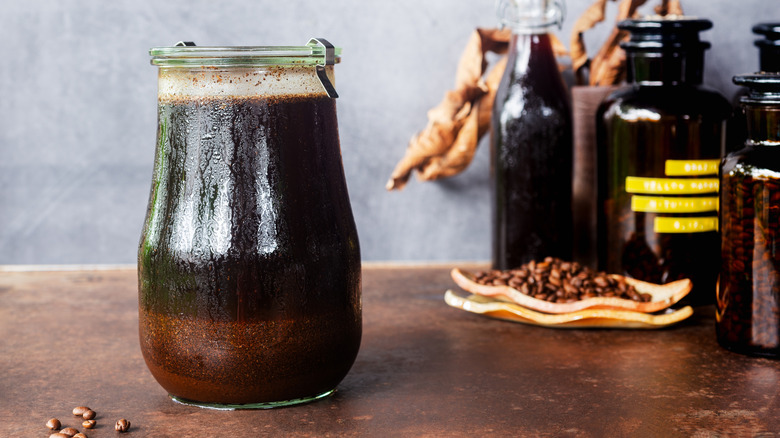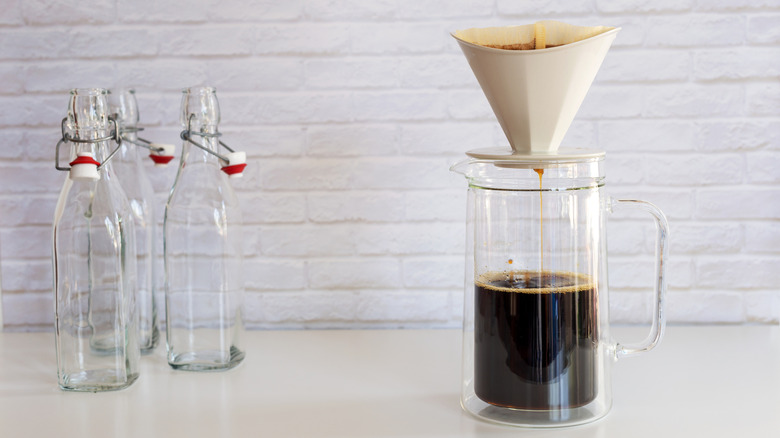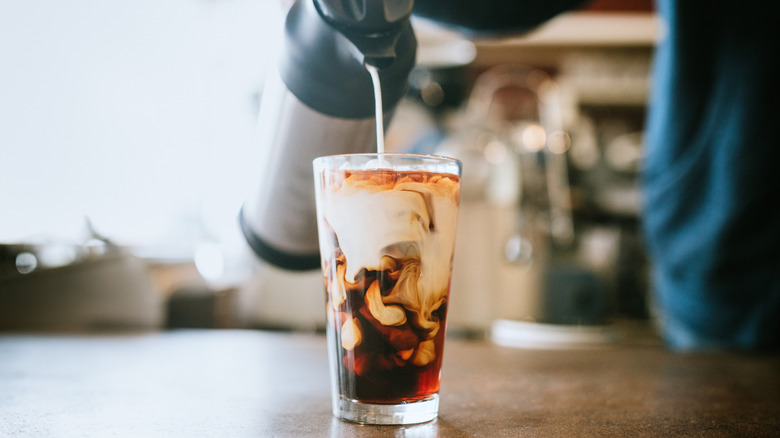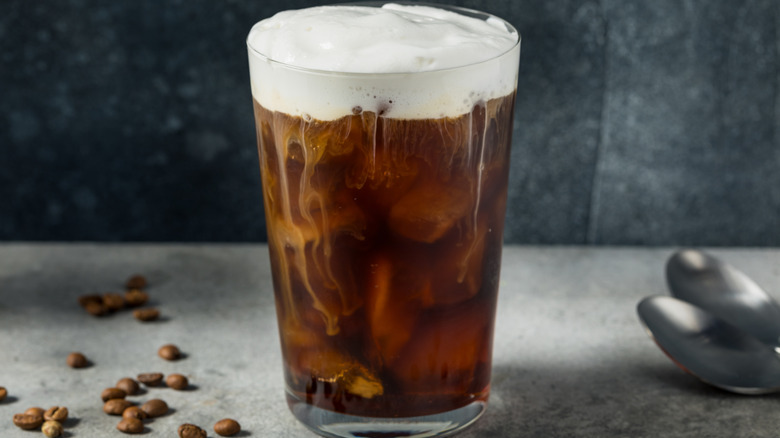5 Mistakes To Avoid When Making Cold Brew At Home
At first glance, making cold brew at home seems simple enough: Grind some coffee beans, soak them in a jar of cold or room temperature water, and let them steep slowly for a few hours. When brewed correctly, the result is a potent dark drink that is rich, intense, and strong – but also subtly sweet and incredibly smooth at the same time. Because no hot water is used, scalding and over-extracting the beans, cold brew is also less acidic, bitter, and sour than other javas — making it a deliciously easy caffeinated beverage to sip on warm, sticky summer days.
So, why is your homemade cold brew laced with a dry sourness — or a bitter and sharp astringency sometimes? Why does it have a thin and runny consistency or an overall bland and lackluster flavor? Well, chances are you've most likely made a mistake somewhere along the way — and an entirely avoidable one at that. Although making cold brew is a fairly straightforward process, it's easy to go wrong, which is why Food Republic spoke to coffee expert Matt Woodburn-Simmonds, the owner of Home Coffee Expert, for his cold brew tips. The ex-barista listed some of the most common mistakes people make while preparing cold brew at home, and how to avoid them in the future. You never have to settle for mediocre cold brew ever again.
Choosing the wrong grind size for your coffee beans
If your cold brew tastes dull or has a sharp edge of bitterness, it's a good idea to check the grind size of the coffee beans that you're using. Matt Woodburn-Simmonds says that cold brew requires coarse coffee grounds that are similar to the ones that you would use in a French press — perhaps even coarser. The texture of these grounds should resemble that of cornmeal or granulated sugar. Anything less and the "finely ground coffee will extract too fast and you'll be left with a big jar of bitterness," he explains.
This is because grinding increases the surface area of the coffee beans, which determines how rapidly water passes through and extracts flavors from them. Quick brewing methods like espresso machines require finer coffee beans with a larger surface area to extract greater flavor in a short period of time. On the flip side, cold brew brewing, which involves steeping beans in water for several hours, requires coarser, looser grounds with less surface area. Using finer grounds here can lead to over-extraction, which will only give the drink an unpleasant flavor.
Not steeping the grounds for long enough
Brew time plays a huge role in determining how good a cup of coffee ultimately turns out to be, and the same goes for cold brew. Matt Woodburn-Simmonds notes that most recipes require the grounds to be soaked in water for 12 hours, which is usually fine if the cold brew is steeped at room temperature.
However, the brew time increases by three to six hours if you're steeping in a refrigerator. In that case, make sure to steep the coffee grounds for 18 hours so that the flavors have enough time to fully extract in the cold temperature. Take it out too soon, and you'll find that your cold brew is disappointingly weak, bland, and astringent. That said, don't let the grounds steep for any longer than about 24 hours either — that can lead to over-extraction, and that's never a good thing.
Using pressure to strain the cold brew
Once the grounds are done steeping, the next step is to strain them. This requires patience, and hastening through the process is a far too common mistake that can taint your cold brew with an unappealing flavor. Matt Woodburn-Simmonds' advice is to "use coffee filters and let gravity slowly filter the grounds from your brew." This can take as long as 30 minutes, but he insists that "it's worth the time."
As tempting as it may be to pop the grounds in a cheesecloth and squeeze them to speed things up, the pressure will do more harm than good. You'll find that your otherwise sweet and smooth cold brew is now laced with bitter or acidic notes, which really isn't a price worth paying for a quicker cold brew.
Drinking the cold brew as it is
Regardless of whether you're making cold brew iced coffee using a French press or a whipping siphon, a big misconception is that once you're done straining the grounds, the resulting liquid is ready to be poured into a glass and drunk on its own. However, our coffee expert Matt Woodburn-Simmonds warns otherwise: "Remember it's [a] concentrate. It's not designed to be glugged straight from the fridge."
In a nutshell: Don't drink that liquid neat. Instead, think of the cold brew as a shot of espresso that you would cut with a splash of milk or creamer. You could even dilute it with half or equal parts of water depending on how strong you want your joe to be, or serve it over ice with a splash of your favorite creamer.
Being stingy with your cold brew batches
The general rule of thumb is to brew coffee fresh as and when you need it. Coffee simply isn't something that you would prep ahead of time and make big batches of in one go. But that's not the case with cold brew. Making cold brew is a time-consuming process, to say the least, but there is good news. Matt Woodburn-Simmonds says that cold brew is a type of cold coffee that "stays fresh for a week or two in the fridge," which only means one thing: "Go BIG."
Rather than brewing a measly glass or two of cold brew, steep enough grounds in water to make at least a week's worth of supply at a time. Simply strain the brew and store it in an airtight jug in the fridge until you're ready to drink it. Just make sure to leave the cold brew untouched in the refrigerator if you plan to store it. Diluting the drink with water, dairy, and the like beforehand will drastically reduce its lifespan to two or three days.

